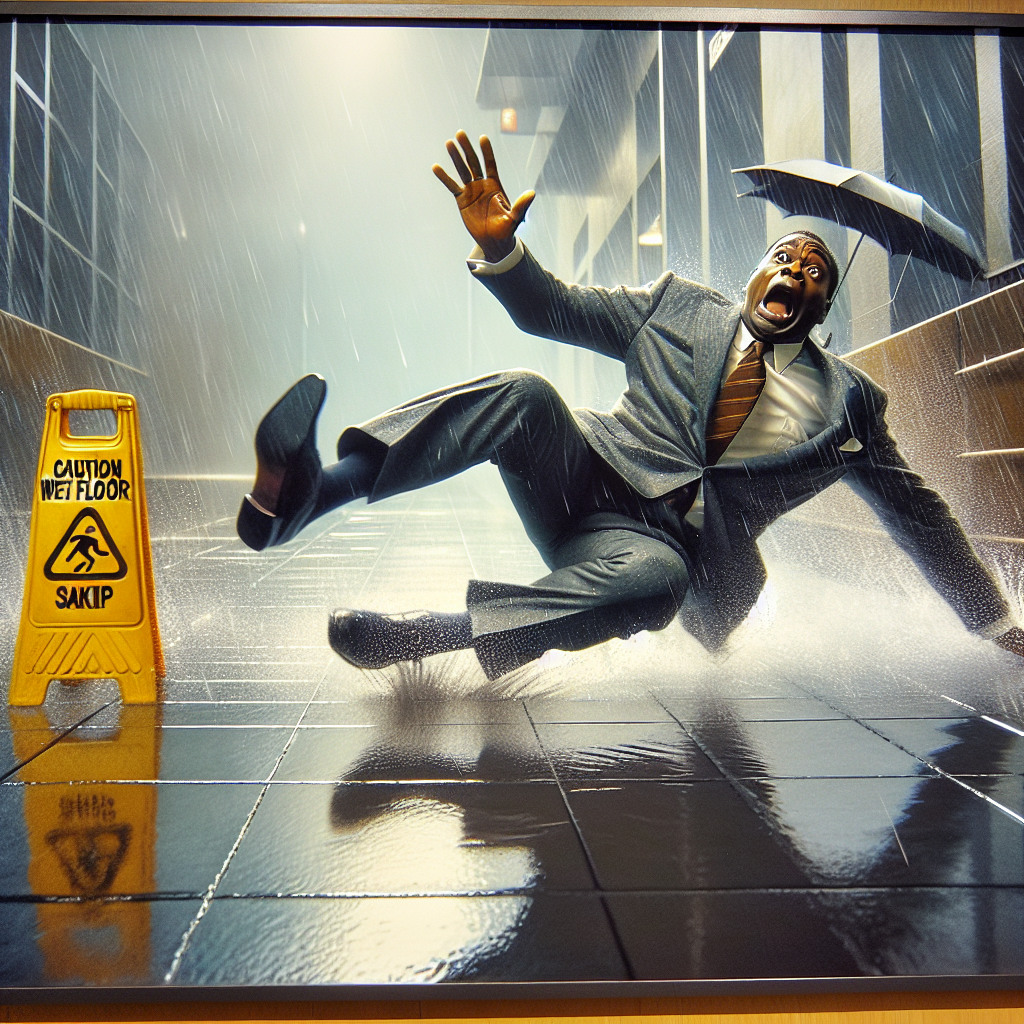Slip and fall accidents, as the name suggests, refer to situations where an individual slips, trips, or falls due to an unsafe condition on someone else’s property. These can occur in a range of settings such as private residences, commercial businesses, public spaces, and even at workplaces. The accidents often result from hazards like uneven flooring, poor lighting, wet surfaces, snow or ice, and cluttered walkways.
The Role of Negligence in Slip and Fall Accidents
It is crucial to understand that not all slip and fall accidents automatically qualify for legal action or compensation. The concept of negligence often plays an instrumental role in these cases. Property owners have a ‘duty of care’ towards the people on their premises. If it can be proven that this duty was breached due to their negligence – say by not maintaining the environment or ignoring potential hazards – then they may be held liable for the accident.
Understanding Liability and Compensation
In most slip and fall incidents, determining who is legally responsible is a complex task. The liability typically relies on whether the property owner acted cautiously to prevent slipping or tripping, and whether the injured party was careless in not seeing or avoiding the condition that led to the fall. Regarding compensation, several factors could affect your claim such as the severity of your injury, your role in the accident, and the specifics of your state’s personal injury laws. Therefore, legal advice might be needed to navigate this often murky process.
Your Legal Rights after a Slip and Fall Incident
Understanding Your Legal Rights
After a slip and fall incident, it’s essential to understand that you have specific legal rights. If your accident was due to someone else’s negligence or wrongdoing, you might be entitled to compensation for your injuries, including medical bills, lost earnings, and even emotional distress.
Firstly, you have the right to file a personal injury lawsuit against the party responsible for your injuries. This includes property owners or management companies who failed to maintain a safe environment. The onus is on you to prove that the responsible party knew, or should have known, about the hazardous condition but did not take the necessary measures to correct it.
Pursuing Compensation
When pursuing compensation after a slip and fall accident, you’re entitled to be compensated for both economic and non-economic damages. Economic damages include measurable costs like medical expenses, lost income, and any future earning capacity. Non-economic damages, often referred to as “pain and suffering”, cover the physical and emotional stress caused by the incident.
Remember, every state has specific laws regarding personal injury cases, including statutes of limitations. This is a fixed period within which you must file your lawsuit. In most states, the clock starts ticking from the date of the incident. Failure to file within this time frame may result in losing your right to financial recovery.
Defending Your Rights
When you decide to exercise your legal rights, you might come across defenses from the other party. Be ready for arguments, such as you being partially or entirely at fault for your fall. They might claim that you were not paying attention, there were warning signs that you ignored, or you were in an area where visitors are usually not allowed. While these arguments may be brought up, it doesn’t necessarily mean they’ll hold in court. Proving negligence on their part is key, and strong evidence can bolster your case.
Knowledge of your legal rights after a slip and fall incident enables you to take the necessary steps to ensure just compensation for your injuries. It’s highly advisable to work with a qualified attorney who understands the complexities surrounding such cases to ensure you get the best possible outcome.
The Role of Negligence in Slip and Fall Accidents
In the legal world, negligence plays a pivotal role in slip and fall accidents. This factor is integral to determining responsibility for the accident and how liability is assigned.
Understanding Negligence
Negligence refers to an entity’s failure to exercise appropriate and/or ethical care that is expected to be performed under particular circumstances. In simpler terms, negligence can be seen as carelessness or the absence of proper attention when it is dutifully required. The person or party who fails to act prudently, leading to injury or harm to another, is deemed negligent.
In resemblance to other personal injury claims, slip and fall cases depends heavily on proving negligence. If the injured party or ‘plaintiff’ can demonstrate that the property owner or ‘defendant’ behaved negligently, the chances of a successful claim rise significantly.
Negligence in Slip and Fall Cases
In the context of slip and fall accidents, negligence usually involves proving that a property owner has knowingly allowed a dangerous condition to exist. This could be a wet floor, an unsecured carpet, dangerously uneven flooring, or even poor lighting conditions, which caused the accident.
To be deemed negligent, the defendant must have been aware or should have been reasonably aware of the hazardous condition but failed to take action to rectify the situation. So, if a plaintiff slips on an icy sidewalk that hasn’t been cleared by the property owner within a reasonable time frame after a snowfall, the owner could potentially be held liable for negligence.
Proving Negligence
Proving negligence is not always straightforward. To achieve this, the plaintiff typically needs to show: firstly, that a duty of care existed; secondly, this duty was breached by the responsible party; thirdly, this breach directly resulted in the accident; and finally, the accident caused damages or injuries to the plaintiff.
Documenting the condition that caused the fall, seeking immediate medical attention, and obtaining any available surveillance footage can significantly help establish negligence. Furthermore, legal advice is often vital in these complex legal processes to ensure that victims of slip and fall accidents are fully aware of their rights and potential compensation.
Calculating Compensation: Factors to Consider
In the realm of slip and fall accidents, determining appropriate compensation involves a variety of factors. Each element influences the potential monetary recompense an injured party may receive.
Nature and Severity of the Injury
The type and degree of injury sustained in a slip and fall accident significantly impact the calculated compensation. Generally, severe injuries such as fractures or those requiring surgery result in a higher compensation level compared with mild injuries like bruises or superficial cuts. Consideration also goes towards future health implications related to the injury, including ongoing care costs, therapy, and extended medical treatments.
Medical Expenses
Medical costs comprise a large portion of the compensation calculation. This is not just limited to immediate healthcare expenses following the accident. You should also consider future medical bills that may arise from the injury. These could include physical therapy sessions, follow-up visits, surgical procedures, and medication costs. It’s essential to keep detailed records of all these expenses as they will help in calculating accurate compensation.
Economic Losses
Apart from medical bills, another critical aspect to consider is the economic impact of the injury. This includes lost wages due to time off work during recovery and reduced earning potential if you’re no longer able to perform your job at the same capacity. If your ability to work has been permanently impaired due to the injury, the loss of future earnings becomes a significant factor in determining compensation.
Non-Economic Damages
Aside from tangible financial losses, compensation may also cover non-economic damages. These include pain and suffering, emotional distress, loss of enjoyment of life, and loss of companionship. Calculating these damages can be more challenging as there are no set standards, and the amounts often depend on subjective factors like the jury or judge’s discretion.
Remember that each case is unique, and the determining factors for compensation may vary depending on state laws and the specifics of the accident. It is advisable to consult with a legal professional who specializes in personal injury law to guide you through this complex process.
How to File a Claim for a Slip and Fall Accident
Identifying the Details of the Accident
The first step in filing a slip and fall claim involves documenting the details of the event accurately. At this point, it is crucial to take photographs of the accident scene, as well as to note any conditions that may have contributed to the incident (including poor lighting, unsafe surfaces, or missing warning signs). If there were witnesses, gather their contact details and statements if possible.
Seek Medical Attention Immediately
Always seek immediate medical attention after a slip and fall accident, even if you don’t believe your injuries warrant it. This step can result in a documented correlation between the incident and your injuries, which can be a deciding factor when filing your claim. Ensure that all injuries, however minor they may seem, are noted in your medical records.
Contacting Legal Professionals
Next, consult with a knowledgeable personal injury attorney who specializes in slip and fall cases. They can guide you through the process of properly filing a claim, providing advice on the expected timeline and potential outcomes. Your lawyer will organize the necessary documents and evidentiary support to establish liability and calculate the compensation due based on the severity of the injuries, cost of medical bills, lost wages, and emotional distress.
Filing Your Claim
In general, reporting the incident to the property owner or manager is the first step in formally filing your claim. Your attorney will then draft a detailed demand letter outlining the facts of the case, the nature of your injuries, medical treatment received, and the amount of compensation you’re seeking. This letter is sent to the at-fault party or their insurance company.
Remember to adhere to the statute of limitations (the legal deadline for filing your lawsuit) in your jurisdiction. While this period can vary by state, it is typically two years from the date of the accident. Always verify this deadline with your attorney to ensure timely filing of your claim.



